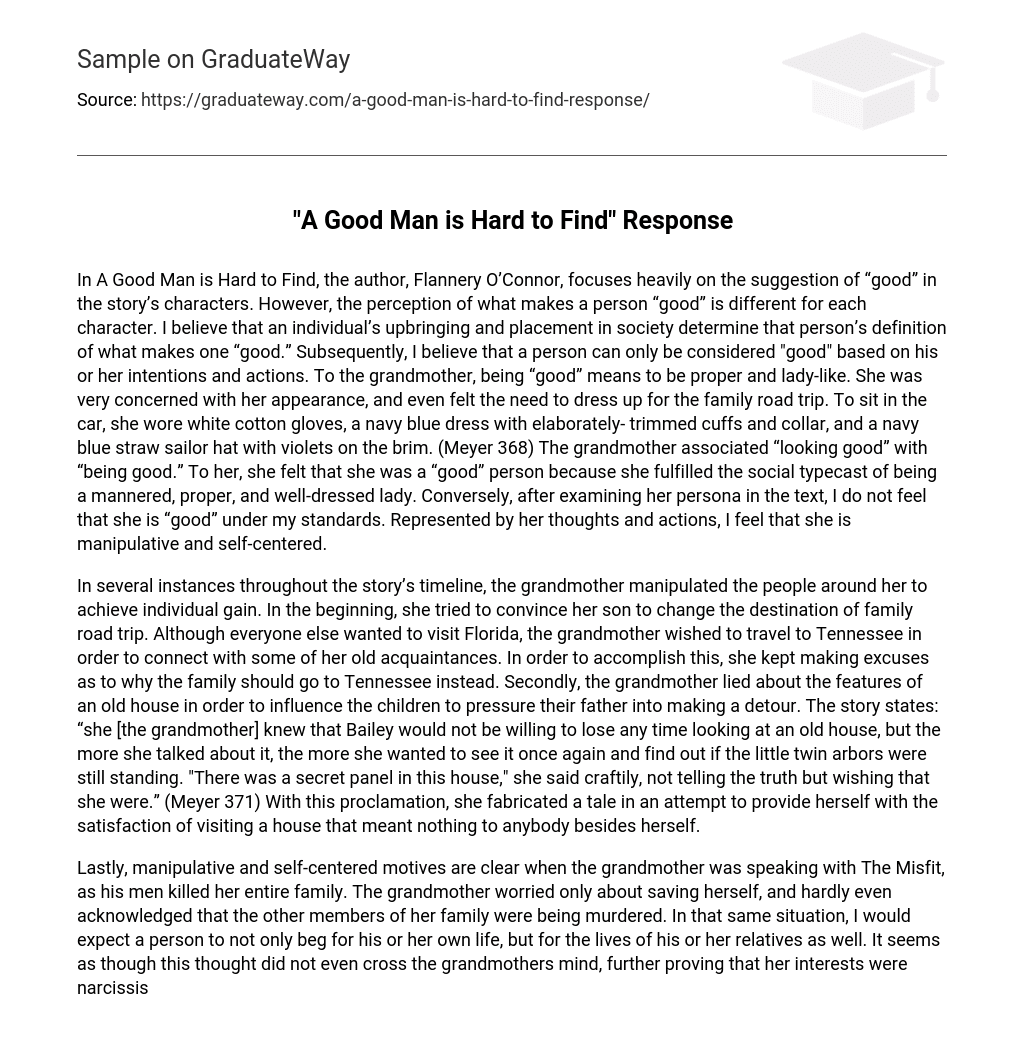Flannery O’Connor’s A Good Man is Hard to Find explores the concept of goodness, as different characters hold varying definitions of what it means to be a good person. Personally, I believe that one’s understanding of goodness is influenced by their upbringing and societal position. Additionally, I believe that an individual can only be considered good based on their intentions and actions.
In the story, the grandmother associates being good with behaving properly and exhibiting ladylike qualities. This belief is evident in her meticulous attention to her appearance during the family road trip; she wears white cotton gloves, a navy blue dress with intricate cuffs and collar, and a navy blue straw sailor hat adorned with violets on its brim (Meyer 368). The grandmother equates looking good with being good. However, upon analyzing her thoughts and behaviors in the text closely, I find her lacking according to my own criteria for goodness. She appears manipulative and self-centered.
The grandmother in the story manipulated those around her for personal gain on multiple occasions. Initially, she tried to persuade her son to change their family road trip destination. Despite the others wanting to go to Florida, the grandmother desired to travel to Tennessee so she could reconnect with old acquaintances. To achieve this, she continuously provided excuses for why Tennessee was a better option. Additionally, the grandmother deceived the children about the qualities of an old house, hoping they would pressure their father into making a detour. According to the story, “she [the grandmother] knew that Bailey would not be willing to lose any time looking at an old house, but the more she talked about it, the more she wanted to see it once again and find out if the little twin arbors were still standing. ‘There was a secret panel in this house,’ she said craftily, not telling the truth but wishing that she were.” (Meyer 371) By fabricating a story, she aimed to satisfy her own desire of visiting a house that held no significance to anyone else.
In the end, the grandmother’s manipulative and self-centered motives are evident when she spoke with The Misfit, as his men killed her entire family. The grandmother only prioritized her own survival and scarcely acknowledged the murder of her other relatives. In a similar situation, one would expect someone to plead not only for their own life but also for the lives of their loved ones. It appears that this thought didn’t even occur to the grandmother, further confirming her narcissistic interests. Conversely, to Bailey, the father and husband, being “good” entails being a dedicated leader of the family. Despite his lack of communication and somewhat unpleasant personality, his actions demonstrate that he is truly concerned for the well-being of the entire family, not just himself. Bailey took the family on vacation even though we are informed that driving makes him anxious, he made an extra stop so the children could see the old house despite his own reluctance, and when confronted with outlaws, he made every effort to assist his family– not just himself.
When The Misfit takes Bailey and John Wesley, Bailey tries to protect his family by stating, “Listen, we’re in a terrible predicament! Nobody realizes what this is.” (Meyer 374) Instead of begging for mercy, he strives to free the whole family from the situation. In my opinion, Bailey is clearly “good” because both his intentions and actions show his concern for his family and the well-being of everyone involved. I believe that a person’s “goodness” can only be determined by their intentions and actions. After examining both the grandmother and Bailey, I do not consider them both as “good.” While Bailey prioritizes the welfare of the family, the grandmother only focuses on her own well-being. After reading A Good Man is Hard to Find, I conclude that although each character believes themselves to be “good,” they do not meet my standards of goodness.
Work Cited
Meyer, Michael. The Compact Bedford Introduction to Literature. 8th Edition. Boston:
Bedford/St. Martin’s, 2009. 367-377. Print.





